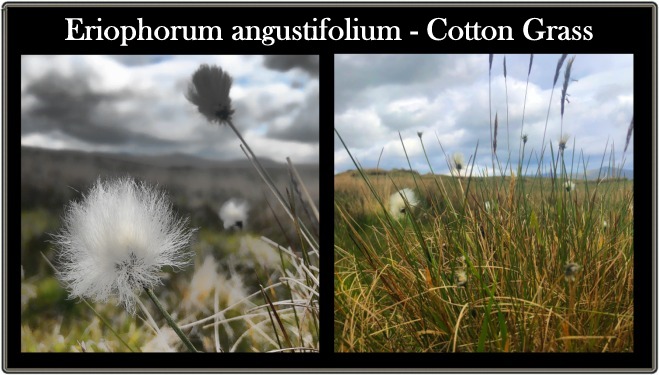
During the months of May and June much of the wet bogs and mires will be sporting a mantle of fluffy white tufts swaying gently in the moorland breezes. No matter what route one chooses on upland Dartmoor it is in many places impossible to walk in a straight line due to obstacles such as bogs and mires. But thanks to cotton grass nature provides an excellent indicator that wet ground is ahead and a slight detour may well be advisable. In addition the direction in which the tufts wave can be a good indicator as to the strength and direction of the wind which with a practiced eye will foretell of any changes in the weather pattern.
Eriophorum angustifolium – known locally on Dartmoor as ‘Piskie Wool’, Pixie Grass, or Piskie Flax (see below) and more universally as Cotton Grass and Bog Cotton’. Cotton grass does in fact belong to the order of sedges not grasses. It can be found in almost any wet peaty places, bogs or mires that occur on Dartmoor. It is a creeping rhizomatous perennial plant that has an abundance of unbranched, translucent pink roots. Cotton grass has a tall, erect stem shaped to a narrow cylinder. To the touch it has a smooth texture which is green in colour. Its height can vary between 60 and 80 centimetres and has a “stiff grass-like foliage” made up of long, narrow solidly dark green leaves, which have a single central groove. Come May the plant produces 1–7 conspicuous spikelets which develop into the fluffy white cotton-like heads which transform the drab landscape. The plant reproduces when the wind blows the fluffy fibres into the air and then hence disperses the seeds for new growth. It is termed as a ‘characteristic plant‘ of both valley mires and blanket bog.

FOLKLORE.
It was believed that anyone who plucked cotton grass from it’s marshy home would surely invite the wrath of the piskies because they used it for weaving – hence the name ‘Piskie Grass’.
One tradition is that when crossing a bog or mire the feathery tufts will begin to dance and entice the wanderer to follow them until finally they end up in a bottomless miry pit known as a ‘Piskie Hole’. It was believed that it was the piskies deliberately planted the ‘piskie grass’ in order to lure the unwary travellers.
USES.
The main use of cotton grass was to harvest the cotton-like tufts for stuffing pillow cases but it took a great deal of work to collect enough for such purposes.
The seed heads of cotton grass would when dried serve a wicks.
Although people attempted to spinning with cotton grass it was never viable as the fibre lacks a natural twist which made the process hugely time consuming and expensive.
Following the liquidation of the West of England Peat Company back in 1883 the liquidator published a notice suggesting that it would be possible to supply 500 tons a week of cotton grass peat litter for the purpose of being used as animal bedding.
Although there is no evidence on Dartmoor some upland areas of the UK used the cotton heads as a component of baby nappies, presumably to make them more comfortable?
The leaves and roots are said to be highly astringent and has been used as wound dressings and supposedly a treatment for diarrhoea.
The grass moth Caleptris pinella has a particular fancy for cotton grass as a source for its food.
Cotton Grass is often used as decorative plant around garden ponds etc., with a single plant costing around £2.50 p.
The cotton grass heads have been known to be used as a tinder for lighting fires in a ‘survival’ context.
 Legendary Dartmoor The many aspects past and present of Dartmoor
Legendary Dartmoor The many aspects past and present of Dartmoor
